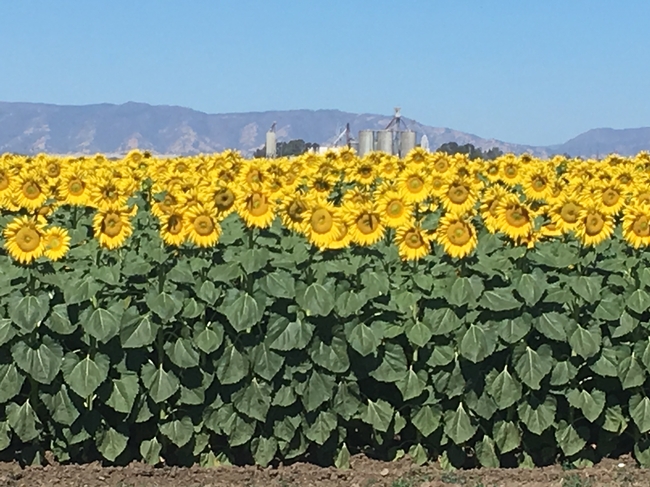Sunflowers
A few evenings back, driving into town, I saw a young woman park her minivan next to a field of sunflowers. She and a little girl got out of their car and walked up to the flowers. The little girl was about the same height as the shorter stalked variety, while the woman was towered over by the taller type. I have passed the fields of sunflowers each summer in our area for many years. I have always enjoyed looking at the tournesols, as the French call them, translated “turns towards the sun”. While some think of Provence when seeing sunflowers, they actually originated in North America. Of approximately 70 varieties only 3 originated in South America.
Sunflowers were first cultivated by Native Americans. The seeds were pounded into flour for bread or cracked and eaten raw or crushed for oil. Other parts of the plant were used for body ointment, dyes, medicine, building material and ceremonial use. The Spanish explorers took the seed to Europe in the 1500's, and it has flourished there since. In the early 1700s, an Englishman devised a way to squeeze the oil from the seed on a larger scale basis. Russia became the largest grower in the 1800s. Today Ukraine is Number 1 and Russia Number 2 as the top growers in the world. The US has about 3 million acres planted with sunflowers and about 90% is of the type used for making sunflower oil. The seed pulp that is left after crushing and squeezing for the oil is used for livestock feed. Whole seeds are used for human snack food and for birdseed.
Something you may not know about sunflowers is that they were planted at Chernobyl and Fukushima after the radiation accidents at each place. A researcher from the University of Virginia, Catie Kitrinos has found that some (not all) sunflower varieties can remove toxins (lead, zinc, uranium) from the soil while growing, a process called phytoremediation. The plants are safely destroyed (not eaten) after they have matured. This process is much less costly in taking care of radioactive or heavy metal-laden soil.
Sunflowers grow quickly reaching their full height in about 120 days. Their roots can be 9 feet deep. In the fall, after they have dried on the stalk, the sunflower heads are harvested. The larger black seeds are typically used for oil, the striped ones for human snack food, and the smaller black seeds for birdseed. Birds don't actually care if seeds are striped or black and will eat what they find. Since each sunflower head can produce up to 1000 seeds, there should be plenty to share.
Comments:
Thanks!



I live in the country in Winters, and see many photographers and their clients out near these beauties. They are an aMAZing piece of beauty. Just hoping I can jump in here to remind people to respect the farmers, and their crops, which are their livelyhoods. Climbing around among the flowers can cause damage to their irrigation arrangement, plus I have seen young
beauties get badly injured (in high heels and full make-up and hair) while accessing the place for their perfect shot. "Be Careful Out There!!"
Again, Thank You for the interesting history of these lovelies we are surrounded by. We are so fortunate to live in such a beautiful County!!
(Katie steps off of the soap box :) )
Posted by Katie Mertz on September 13, 2018 at 2:34 PM